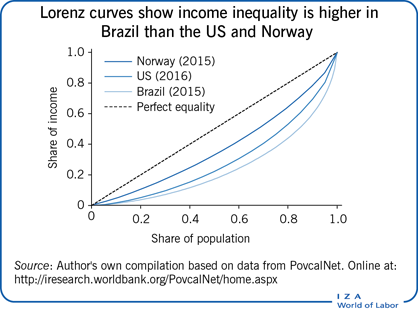Elevator pitch
Economists use various metrics for measuring income inequality. Here, the most commonly used measures—the Lorenz curve, the Gini coefficient, decile ratios, the Palma ratio, and the Theil index—are discussed in relation to their benefits and limitations. Equally important is the choice of what to measure: pre-tax and after-tax income, consumption, and wealth are useful indicators; and different sources of income such as wages, capital gains, taxes, and benefits can be examined. Understanding the dimensions of economic inequality is a key first step toward choosing the right policies to address it.

Key findings
Pros
The Lorenz curve is a commonly used metric that allows for the quick and visual comparison of inequality across countries.
The Gini coefficient uses information from the entire income distribution and is independent of the size of a country’s economy and population.
Percentile ratios are easy to calculate and focus on a specific region of the distribution.
The Theil index can decompose inequality into within- and between-group inequality.
These commonly used measures are generally in agreement when comparing inequality across countries.
Cons
If Lorenz curves cross they cannot provide a conclusive ranking between distributions.
The Gini coefficient values change depending on what is measured—wages, before-or after-tax income, wealth, or consumption.
Percentile ratios fail to use all information since they ignore incomes between percentiles.
The Theil index is less intuitive and not directly comparable across populations with different sizes or group structures.
The evolution of inequality within a country can appear different depending on the metric used.